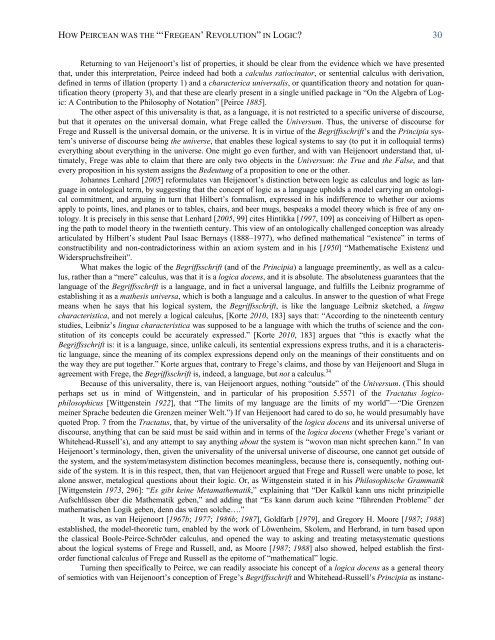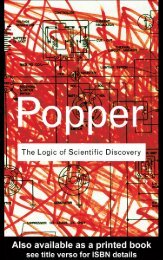You also want an ePaper? Increase the reach of your titles
YUMPU automatically turns print PDFs into web optimized ePapers that Google loves.
HOW PEIRCEAN WAS THE “‘FREGEAN’ REVOLUTION” IN LOGIC? 30<br />
Returning to van Heijenoort’s list of properties, it should be clear from the evidence which we have presented<br />
that, under this interpretation, Peirce indeed had both a calculus ratiocinator, or sentential calculus with derivation,<br />
defined in terms of illation (property 1) and a characterica universalis, or quantification theory and notation for quantification<br />
theory (property 3), and that these are clearly present in a single unified package in “On the Algebra of Logic:<br />
A Contribution to the Philosophy of Notation” [Peirce 1885].<br />
The other aspect of this universality is that, as a language, it is not restricted to a specific universe of discourse,<br />
but that it operates on the universal domain, what Frege called the Universum. Thus, the universe of discourse for<br />
Frege and Russell is the universal domain, or the universe. It is in virtue of the Begriffsschrift’s and the Principia system’s<br />
universe of discourse being the universe, that enables these logical systems to say (to put it in colloquial terms)<br />
everything about everything in the universe. One might go even further, and with van Heijenoort understand that, ultimately,<br />
Frege was able to claim that there are only two objects in the Universum: the True and the False, and that<br />
every proposition in his system assigns the Bedeutung of a proposition to one or the other.<br />
Johannes Lenhard [2005] reformulates van Heijenoort’s distinction between logic as calculus and logic as language<br />
in ontological term, by suggesting that the concept of logic as a language upholds a model carrying an ontological<br />
commitment, and arguing in turn that Hilbert’s formalism, expressed in his indifference to whether our axioms<br />
apply to points, lines, and planes or to tables, chairs, and beer mugs, bespeaks a model theory which is free of any ontology.<br />
It is precisely in this sense that Lenhard [2005, 99] cites Hintikka [1997, 109] as conceiving of Hilbert as opening<br />
the path to model theory in the twentieth century. This view of an ontologically challenged conception was already<br />
articulated by Hilbert’s student Paul Isaac Bernays (1888–1977), who defined mathematical “existence” in terms of<br />
constructibility and non-contradictoriness within an axiom system and in his [1950] “Mathematische Existenz und<br />
Widerspruchsfreiheit”.<br />
What makes the logic of the Begriffsschrift (and of the Principia) a language preeminently, as well as a calculus,<br />
rather than a “mere” calculus, was that it is a logica docens, and it is absolute. The absoluteness guarantees that the<br />
language of the Begriffsschrift is a language, and in fact a universal language, and fulfills the Leibniz programme of<br />
establishing it as a mathesis universa, which is both a language and a calculus. In answer to the question of what Frege<br />
means when he says that his logical system, the Begriffsschrift, is like the language Leibniz sketched, a lingua<br />
characteristica, and not merely a logical calculus, [Korte 2010, 183] says that: “According to the nineteenth century<br />
studies, Leibniz’s lingua characteristica was supposed to be a language with which the truths of science and the constitution<br />
of its concepts could be accurately expressed.” [Korte 2010, 183] argues that “this is exactly what the<br />
Begriffsschrift is: it is a language, since, unlike calculi, its sentential expressions express truths, and it is a characteristic<br />
language, since the meaning of its complex expressions depend only on the meanings of their constituents and on<br />
the way they are put together.” Korte argues that, contrary to Frege’s claims, and those by van Heijenoort and Sluga in<br />
agreement with Frege, the Begriffsschrift is, indeed, a language, but not a calculus. 34<br />
Because of this universality, there is, van Heijenoort argues, nothing “outside” of the Universum. (This should<br />
perhaps set us in mind of Wittgenstein, and in particular of his proposition 5.5571 of the Tractatus logicophilosophicus<br />
[Wittgenstein 1922], that “The limits of my language are the limits of my world”—“Die Grenzen<br />
meiner Sprache bedeuten die Grenzen meiner Welt.”) If van Heijenoort had cared to do so, he would presumably have<br />
quoted Prop. 7 from the Tractatus, that, by virtue of the universality of the logica docens and its universal universe of<br />
discourse, anything that can be said must be said within and in terms of the logica docens (whether Frege’s variant or<br />
Whitehead-Russell’s), and any attempt to say anything about the system is “wovon man nicht sprechen kann.” In van<br />
Heijenoort’s terminology, then, given the universality of the universal universe of discourse, one cannot get outside of<br />
the system, and the system/metasystem distinction becomes meaningless, because there is, consequently, nothing outside<br />
of the system. It is in this respect, then, that van Heijenoort argued that Frege and Russell were unable to pose, let<br />
alone answer, metalogical questions about their logic. Or, as Wittgenstein stated it in his Philosophische Grammatik<br />
[Wittgenstein 1973, 296]: “Es gibt keine Metamathematik,” explaining that “Der Kalkül kann uns nicht prinzipielle<br />
Aufschlüssen über die Mathematik geben,” and adding that “Es kann darum auch keine “führenden Probleme” der<br />
mathematischen Logik geben, denn das wären solche….”<br />
It was, as van Heijenoort [1967b; 1977; 1986b; 1987], Goldfarb [1979], and Gregory H. Moore [1987; 1988]<br />
established, the model-theoretic turn, enabled by the work of Löwenheim, Skolem, and Herbrand, in turn based upon<br />
the classical Boole-Peirce-Schröder calculus, and opened the way to asking and treating metasystematic questions<br />
about the logical systems of Frege and Russell, and, as Moore [1987; 1988] also showed, helped establish the firstorder<br />
functional calculus of Frege and Russell as the epitome of “mathematical” logic.<br />
Turning then specifically to Peirce, we can readily associate his concept of a logica docens as a general theory<br />
of semiotics with van Heijenoort’s conception of Frege’s Begriffsschrift and Whitehead-Russell’s Principia as instanc-





